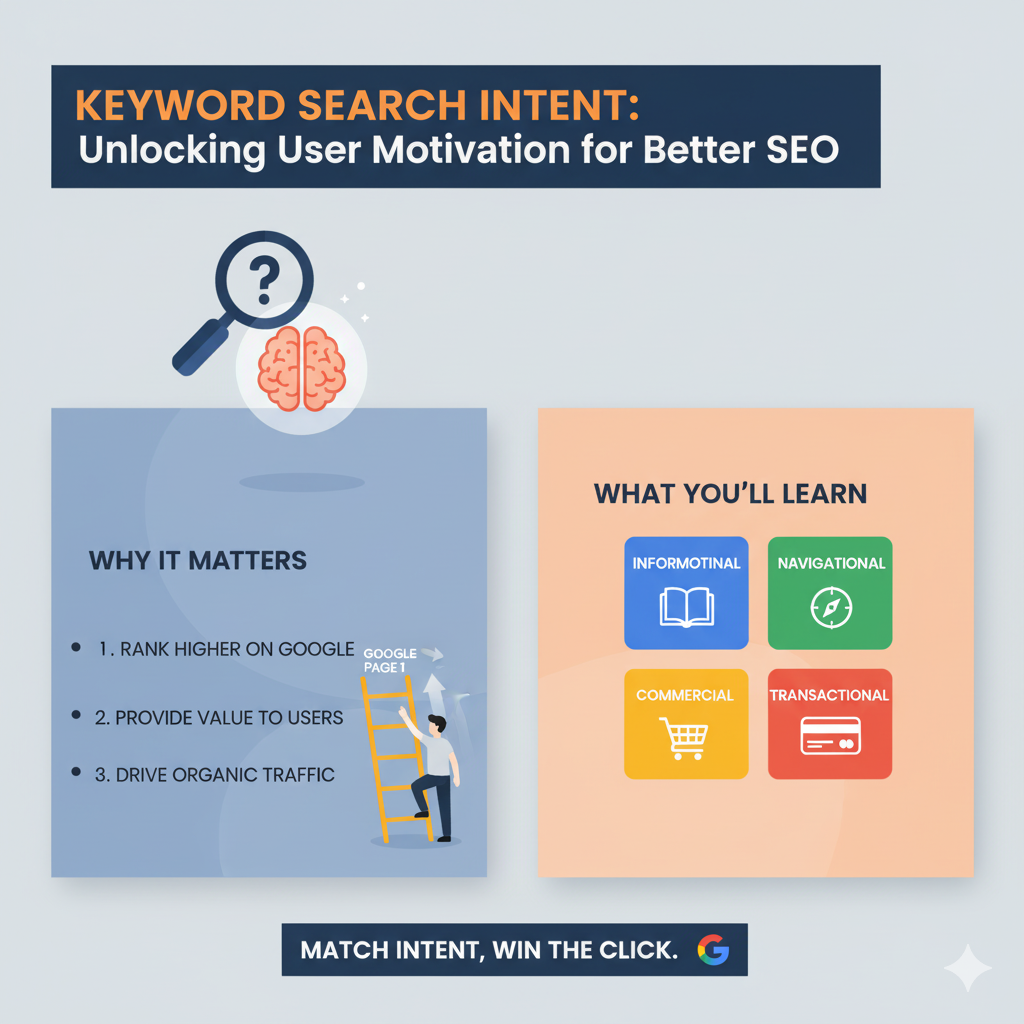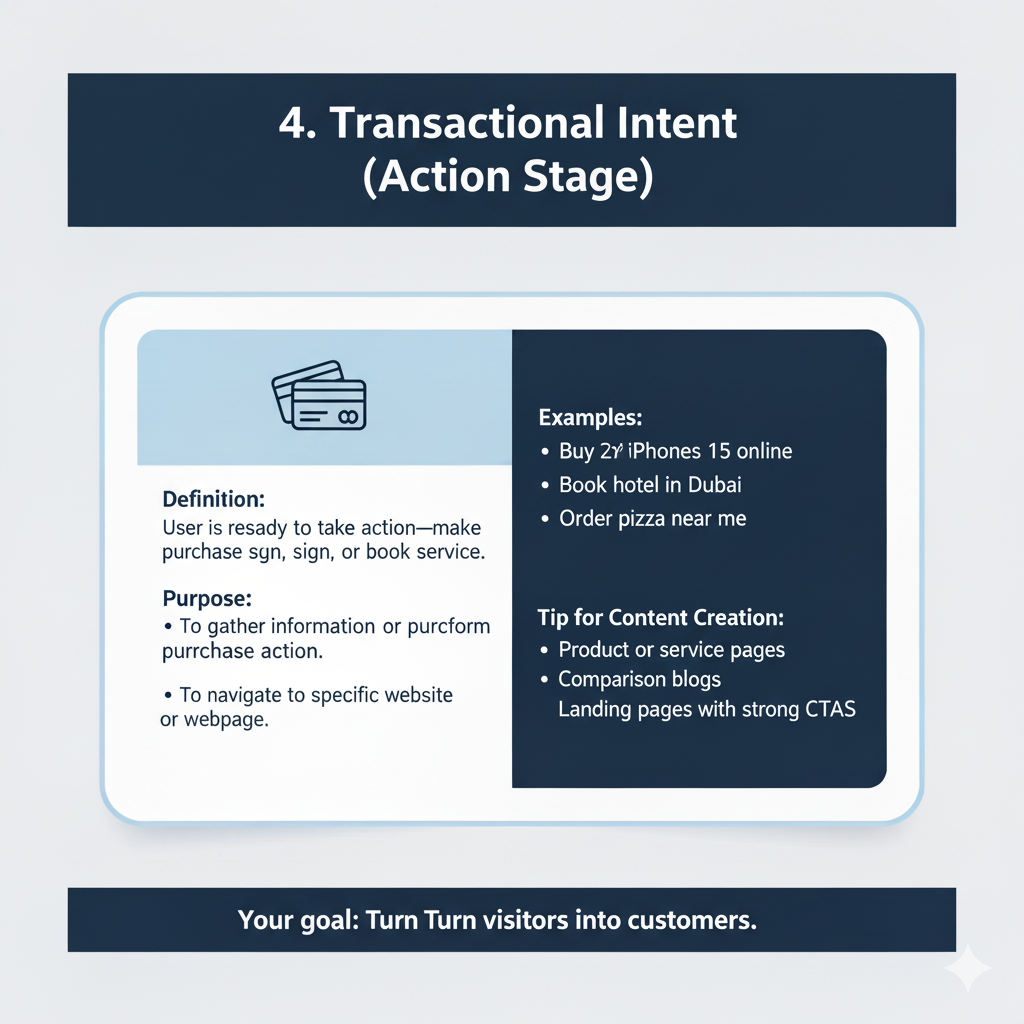Introduction

In SEO, knowing what people search for is important — but understanding why they search for it is even more powerful. This “why” behind a search is known as Keyword Search Intent.
If you want your website to rank higher on Google, your content must match the user’s intent. In short, Google rewards content that gives users exactly what they are looking for.
Let’s explore what search intent means, why it matters, and the four main types every beginner should know.
What Is Keyword Search Intent?

Keyword Search Intent (also called User Intent or Search Intent) is the reason behind a user’s search query on Google or any search engine.
When someone types something into the search bar, they have a purpose in mind — maybe to learn, find, compare, or buy. Your job as a content creator or marketer is to understand that purpose and create content that fulfills it.
Why Is Search Intent Important for SEO?
Search intent plays a major role in how Google ranks content. Google wants to give users the most relevant and helpful answers.
If your content doesn’t match what users expect, it won’t rank — even if you use the right keywords.
By understanding search intent, you can:
- Create content that directly answers user needs.
- Improve your ranking potential on Google.
- Increase click-through rates and conversions.
- Build stronger trust and engagement with your audience.
The Four Main Types of Search Intent
Search intent can be divided into four main types: Informational, Navigational, Commercial, and Transactional.
Let’s understand each one in detail with clear definitions, examples, and tips.
1. Informational Intent (Awareness Stage)

Definition:
Informational intent means the user wants to learn something or gain knowledge. They are not looking to buy — they just want information, explanations, or solutions.
Purpose:
To gather knowledge, solve a problem, or understand a topic.
Examples:
- “What is SEO?”
- “How to start meditation”
- “Benefits of drinking green tea”
Tip for Content Creation:
Create educational and informative content such as:
- Blog posts
- Guides and tutorials
- How-to articles
- FAQs
Your goal: Teach and build awareness.
2. Navigational Intent (Interest Stage)

Definition:
Navigational intent means the user wants to find a specific website, page, or brand. They already know what they are looking for and just want to reach that destination.
Purpose:
To navigate to a specific website or webpage.
Examples:
- “YouTube login”
- “Nike official website”
- “Instagram sign-up page”
Tip for Content Creation:
Optimize your website for your brand keywords.
Make sure your pages are easily found and properly indexed.
Your goal: Help users reach your site quickly and easily.
3. Commercial Intent (Desire Stage)

Definition:
Commercial intent means the user is researching products or services before making a purchase. They want to compare options and read reviews before deciding.
Purpose:
To gather information for a future purchase decision.
Examples:
- “Best smartphones under $1000”
- “Top SEO tools for beginners”
- “Nike vs Adidas running shoes review”
Tip for Content Creation:
Create comparison and review-based content, such as:
- Product reviews
- Comparison blogs
- “Top 10” or “Best of” lists
Your goal: Educate and persuade the user to consider your brand.
4. Transactional Intent (Action Stage)

Definition:
Transactional intent means the user is ready to take action — usually to make a purchase, sign up, or book a service.
Purpose:
To complete a transaction or perform a specific action.
Examples:
- “Buy iPhone 15 online”
- “Book hotel in Dubai”
- “Order pizza near me”
Tip for Content Creation:
Create conversion-focused pages like:
- Product or service pages
- Checkout pages
- Landing pages with strong CTAs (Call to Actions)
Your goal: Turn visitors into customers.
The Buyer Journey and Search Intent Connection
Each search intent fits into the buyer journey:
| Stage | Intent Type | Purpose |
|---|---|---|
| Awareness | Informational | Learning or understanding a topic |
| Interest | Navigational | Finding a specific website or brand |
| Desire | Commercial | Comparing options before buying |
| Action | Transactional | Making a purchase or taking action |
By matching your content to each stage, you guide users smoothly from curiosity to conversion.
Best Tools for Keyword Research
Here are some popular tools to help you find the right keywords and understand their intent:
| Tool | Best For |
|---|---|
| Google Keyword Planner | Finding keywords for paid ads and basic SEO |
| Semrush | Advanced SEO professionals and keyword analytics |
| KWFinder | Simple ad hoc keyword research |
| Ubersuggest | Great for content marketing and topic ideas |
Tips to Identify Search Intent Quickly
- Look at Google Results: The type of pages ranking shows the intent (blogs = informational, product pages = transactional).
- Check the Keyword Format: “How,” “What,” “Why” often indicate informational intent; “Buy,” “Best,” “Price” suggest commercial or transactional intent.
- Read Featured Snippets: These show what kind of answers users expect.
- Understand the Audience Goal: Always ask — “What is the user trying to do with this search?”
Search Intent in Digital Marketing (With Examples)

Understanding search intent helps you create content that matches what users are searching for. Here are the four main types of search intent with examples related to a Digital Marketing Agency.
1. Informational Intent
The user wants to learn something. They are not ready to buy yet.
Examples:
- “What is digital marketing?”
- “How does Google Ads work?”
- “Difference between SEO and PPC?”
- “Benefits of social media marketing for small businesses?”
User Goal: Gain knowledge or understand a topic.
2. Navigational Intent
The user is searching for a specific website or platform.
Examples:
- “Avatar Digital Marketing Agency website”
- “Meta Ads Manager login”
- “Google Keyword Planner tool”
- “HubSpot Academy SEO course login”
User Goal: Reach a known website directly.
3. Commercial Intent (Commercial Investigation)
The user is interested in hiring soon but wants to compare options first.
Examples:
- “Best digital marketing agencies in Kochi”
- “Avatar Digital Marketing Agency reviews”
- “SEO services vs Social media marketing – which is better?”
- “Top affordable PPC management companies”
User Goal: Evaluate before making a purchase decision.
4. Transactional Intent
The user is ready to take action—hire, purchase, or book.
Examples:
- “Hire digital marketing agency in Kochi”
- “Buy monthly SEO package for small business”
- “Book consultation with Avatar Digital Marketing Agency”
- “Order social media marketing package now”
User Goal: Confirm and convert (Hire/Buy/Contact).
Conclusion
Understanding Keyword Search Intent is one of the most powerful skills in SEO.
When your content matches user intent, you not only attract visitors — you engage, educate, and convert them.
By creating content that aligns with informational, navigational, commercial, and transactional intent, you build trust and help your audience at every step of their journey.
Start focusing on user intent, and you’ll see your rankings — and your results — improve naturally.